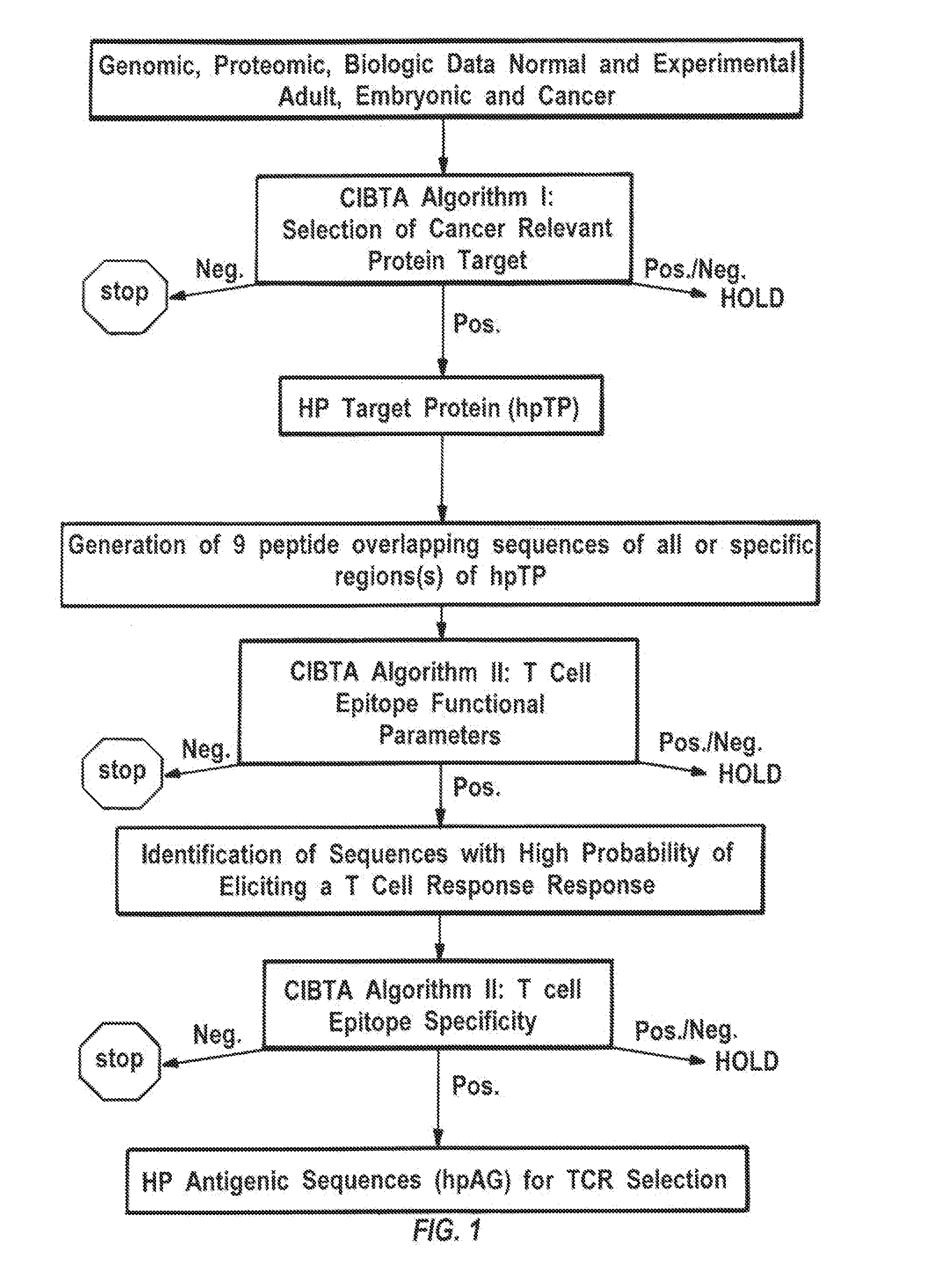Identification, selection and use of high curative potential t cell epitopes
a t cell and epitope technology, applied in the field of identifying t cell epitopes, to achieve the effects of high curative potential, high potency, and high probability of t cell recognition
- Summary
- Abstract
- Description
- Claims
- Application Information
AI Technical Summary
Benefits of technology
Problems solved by technology
Method used
Image
Examples
example 1
Distinguishing High Curative Potential Target Proteins (HP-TP) and Aux-TP from Non-HP-TP and Non-Aux-TP Using Mesothelin as the Example
[0093]The cell surface protein mesothelin has been identified and developed as a target for ACT. Mesothelin is used to illustrate the difference between simply a “cancer marker” or TP and an HP-TP or Aux-TP and how they are qualified. The process applied in this example is not limited to the protein of the example but is generally applicable to all expressed cancer proteins.
[0094]Mesothelin is a cell surface protein highly expressed in mesothelioma, as well as ovarian, pancreatic, and a subset of lung cancers (Somers et al. Biomarker Insights 9:29-37 (2014)). It is a cell surface protein that begins as a precursor that is then split into the cell-membrane-associated protein mesothelin and a soluble megakaryocyte potentiation factor (Somers et al. Biomarker Insights 9:29-37 (2014)). Experts in the field of cancer immunotherapy consider surface-bound m...
example 2
Comparison of HP-Ag Derivation Against an Alternative Method of Target and Epitope Identification for ACT Targeting Cancer Stem Cells
[0106]Many methods to date have had the intent of improving cancer vaccines rather than ACT therapy so their deficiencies in discrimination of HP-TP and HP-Ag are not surprising. However, some approaches have been designed with the goal of identifying cancer proteins and epitopes for ACT targeting cancer stem cells. One such example is the work of Ochsenreuther et al. (2008) (Ochsenreither, et al. Blood 119(23):5492-5501 (2012)) where they describe a protein and epitope discovery approach for ACT therapy to target leukemic stem cells in acute myeloid leukemia. Both the target and HLA A2 9 amino acid (9mer) epitopes identified by Ochsenreuther et al. Blood 119(23):5492-5501 (2012) were compared using the stepwise, gated approach and associated analysis disclosed herein. The complete protein sequence was then analyzed using Step 2 of the methods herein t...
example 3
The Derivation of HP-Ag Peptides Homologous to Sequences within the Fusion Region of the BRD4-NUT Fusion Protein Expressed in NUT Midline Cancers
[0122]BRD4-NUT ((bromodomain containing 4 protein-nuclear protein in testis) is a fusion protein present in a subset of NUT midline cancers. NUT midline carcinomas are non-operable with few treatment options (French Nature Reviews Cancer 14:149-150 (2014)). If BRD4-NUT were a feasible, safe and potent ACT target, it would offer a valuable treatment option for NUT midline carcinoma. These studies were commenced by evaluating the fusion protein for its target potential based on the parameters of frequency, pattern of expression, and its clinical and commercial feasibility (Frequency), its ability to discriminate cancer cells from normal cells (Specificity), and the strength of its functional relationship to the cancer's ability to perpetuate itself (Functional Connectivity).
[0123]Step 1. Qualification of BRD4-NUT as an HP-TP or Aux-TP
[0124]A....
PUM
| Property | Measurement | Unit |
|---|---|---|
| frequency | aaaaa | aaaaa |
| strength | aaaaa | aaaaa |
| durable | aaaaa | aaaaa |
Abstract
Description
Claims
Application Information
 Login to View More
Login to View More - R&D
- Intellectual Property
- Life Sciences
- Materials
- Tech Scout
- Unparalleled Data Quality
- Higher Quality Content
- 60% Fewer Hallucinations
Browse by: Latest US Patents, China's latest patents, Technical Efficacy Thesaurus, Application Domain, Technology Topic, Popular Technical Reports.
© 2025 PatSnap. All rights reserved.Legal|Privacy policy|Modern Slavery Act Transparency Statement|Sitemap|About US| Contact US: help@patsnap.com

